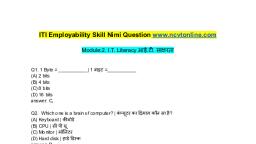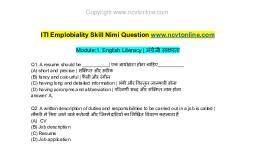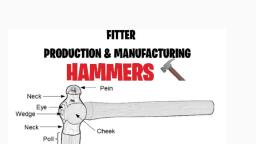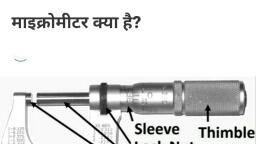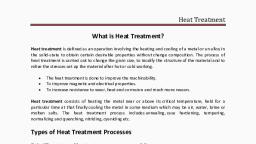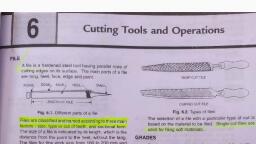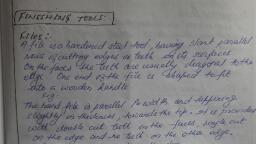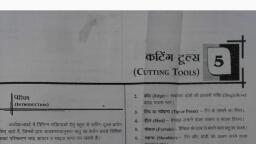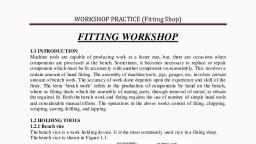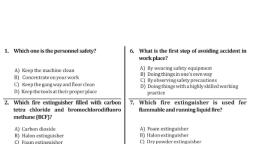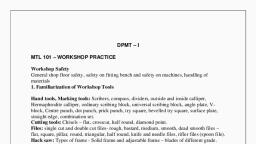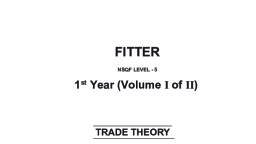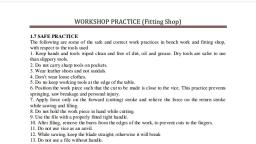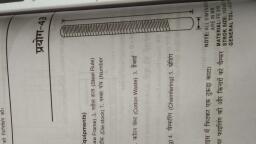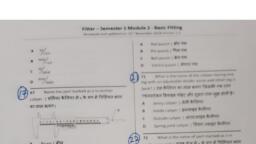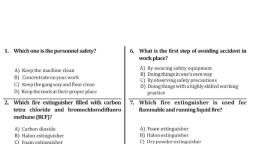Page 1 :
Types of File Tools, , Files Tools and Its Types, A file is used to cut, trim or finish a job of metal or wood, in order to give them, a shape according to our needs such as making the job round, square or, angular. File is made from high carbon steel., The file is a hard steel instrument with numerous cutting points. Metal is cut, in small or tiny particles with the help of a file. Therefore, mostly a file is used, for giving final finishing touches to a job of metal or wood., After chipping a job of metal generally becomes rough and a file is used to, make it smooth. In case of a machine, the part is larger in size than the, required size, a file is used to make it suitable., In addition, a file is used where other cutting tools cannot be used. Files are, also used for sharpening the edge of some other cutting tools., , Parts of a File, It has the following main parts of a file:, , 1., 2., 3., 4., 5., 6., , Handle, Tang, Heel, Face, Edge, Tip or Point, , A wooden handle is fitted on its tang. Teeth are cut on its face and edge so that, it can perform the job of cutting. The part having no teeth is called as heel., Thick side of file is called edge and its lower end is known as tip or point., Read also: Chisel: Types, Parts, Methods, Precautions with PDF, , TheEngineersPost.com, , Page 1
Page 2 :
Types of File Tools, , Types of File Tools, While making a selection of file for a specific job, some important points should, be considered. In other words, we can say that files can be classified into the, following categories:, 1. On the basis of length, 2. On the basis of shape, 1. Flat file, 2. Round file, 3. Half-round file, 4. Triangular file, 5. Square file, 6. Hand file, 7. Knife file, 3. In the basis of grades, 1. Rough File, 2. Bastard File, 3. Second cut File, 4. Smooth File, 5. Dead Smooth File, 4. On the basis of cut, 1. Single Cut File, 2. Double Cut File, 3. Curved Cut File, 4. Spiral Cut File, 5. Rasp Cut File, , 1. Classification According to Length, A file is measured according to its length. This length includes whole file except, its tang portion i.e. length from heel to tip is the measurement of the file. In, fitter trade, file of 100 mm to 450 mm length are used., , 2. Classification According to Shape, Following are the different types of file tools according to its shape:, 1. Flat File, , TheEngineersPost.com, , Page 2
Page 3 :
Types of File Tools, This file is of rectangular cross-section in shape. It is made slightly tapered, both in width and thickness. Double cut teeth are cut on the face and simplecut teeth are cut on the edge. These are used to reduce flat surface by filing of, finishing., 2. Round File, , This type of file has a round section. It is used for rubbing or finishing keyhole, of small diameter., 3. Half-round File, , It is a file which is on the side and curved on the other side. Double cut dents, are cut on it and like a round file, it is also tapered. With this file, the damaged, hole can be set in order again., 3. Triangular File, , It is triangular in shape. Its angles are of 60°. Filing of “V” slots job, square and, rectangular jobs of above 60° and below 90° angle are done with this file. It is, also known as three square files., 4. Square File, , TheEngineersPost.com, , Page 3
Page 4 :
Types of File Tools, It is square in shape and is somewhat tapered. Filing of rectangular, square, groove, slots and key-way is done with this file., 5. Hand File, , This file is almost similar to the flat file. It is used for filing of internal right, angle side of a job. It is also called safe edge file., 6, Knife Edge File, , Its shape is like the edge of a knife. Its thin edge is about 10° angle. It is used, for filing of small grooves and slots whose angle is less than, 60°Error! Filename not specified.. It is generally used in lock industry for, making keys., Read also: 9 Different Types of Sheet Metal Operations with Diagrams, , 3. Classification According to Grade, Following are the different types of file tools according to the basis of the, number of teeth:, 1. Rough File, In this type of file, teeth are of big size and less in number. It, is used for cutting soft materials because its cutting is, rough. Because of rough cutting, it cannot be used for hard, metal., , TheEngineersPost.com, , Page 4
Page 5 :
Types of File Tools, 2. Bastard File, Teeth of this file are comparatively smaller than those of, the rough file. It is used initially to shed metal (through, filing) in large quantity., , 3. Second-cut File, This is a file of medium grade. In the filler trade, this file is, mostly used to bring the job in the proper size. As, compared to the bastard file, filing done with this file, makes the surface plain., , 4. Smooth File, , This file makes the surface quite plain, in addition to, making a job of accurate size through filing., , 5. Dead Smooth File, Its teeth are very close to each other and it rubs off the metal in very little, quantity. It is used for bringing shinning on the job after finishing has been, done., Read also: 13 Main Difference between NC, CNC and DNC Machine, , TheEngineersPost.com, , Page 5
Page 6 :
Types of File Tools, 4. Classification of Files On The Basis of Cut, Following are the different types of file tools according to the cut:, 1. Single-cut File, , This is file has parallel lines of teeth running diagonally across its face in one, direction only. Metal surface is rubbed in little quantity and thus the surface, becomes smooth. Therefore it is used for hard metal and for finishing., 2. Double-cut File, This file has two rows of teeth crossing each other at an angle of 40° to 45° and, the other row has angles of 70° to 80°., , Because of double teeth, this file cuts metal quickly but it cannot make the, surface very smooth. That is why it is generally used for normal filing as shown, in fig (B)., , It is also called a coarse type file. In 30° to 35° and the other row is of 80° to, 87° angles as shown in fig (C)., 3. Curved-cut File, , TheEngineersPost.com, , Page 6
Page 7 :
Types of File Tools, It is also known as Vixen file. The curved-cut file is used for filing of the wide, surfaces of soft metal like aluminium, zinc, copper and brass. It has circular, teeth as shown in fig., 4. Spiral-cut File, , These types of teeth are cut in round or semi-round files. The shape of their, teeth is like that of threads., 5. Rasp-cut File, , This is a file of special thick teeth. These teeth are of triangle shape and are in, a bulging state. It is used for jobs of woods, plastic, fiber, hard rubber, and job, of horns and hoof of animals., , Methods of Filing, In order to get the proper surface through filing, the following points need, consideration:, 1. Choose the right type of file, according to the job., 2. There should be handle fitted on the tang of the file. In small files, a, small handle should be fitted and a larger handle in a larger file., Otherwise, proper and power would be unnecessarily wasted., 3. Hold the handle of the file with the right hand and keep the file end, balanced with the left hand., 4. At the time of filing, the left leg should be kept ahead and the right leg a, little behind as shown in fig., 5. Pressure on the file should be exerted while moving it ahead, not while, driving it back., 6. Only your hands should move with the file and not your whole body. As, far as possible, keep rest of your body still., 7. Speed of moving the file should be at the rate of 30 to 35 strokes per, minute., TheEngineersPost.com, , Page 7
Page 8 :
Types of File Tools, , Precautions of Using Files, Following are the precautions of using files:, 1. Select the file according to the job., 2. Do not use a file without a handle. According to the size, the complete, handle should be fixed on the file., 3. First, a new file should be used on soft metal, and then it can use on, solid metal., 4. If substantial material is to be cut then first chipping should be done and, then filing., 5. For filing of sheet metal jobs, the job should be fixed in a vice by using, wood on both its sides. It should also be ensured that the sheet should, not be higher than vice., 6. While filing a sheet, we should cut it in length., 7. We should make use of chalk in order to save the job from pinning. If, there are metal particles on the file there should be cleaned with a brush., 8. Keep and file away from other tools. They should not be heaped together., 9. The file should not be heated., 10., Do not apply oil or grease to the file., , Applications of Files, Following are the applications of files:, 1. A file is used for giving final finishing touches to a job of metal or wood., 2. After chipping a job of metal generally becomes rough and a file is used, to make it smooth., 3. In case of a machine, the part is larger in size than the required size, a, file is used to make it suitable., 4. In addition, a file is used to where other cutting tools cannot be used., 5. Files are also used for sharpening the edge of some other cutting tools., That’s it, thanks for reading. If you have any questions about “Types of File, Tools” you can ask in the comments., Read Next:, , , , Drilling machine – Parts, It’s Types, Operations with PDF, 22 Different Types of Lathe Machine Operations, , TheEngineersPost.com, , Page 8


